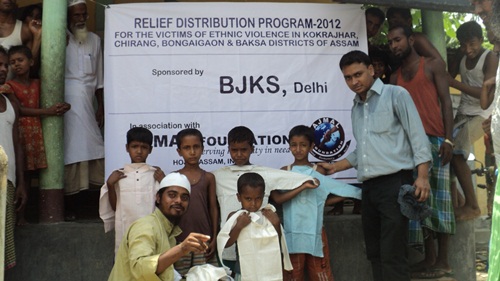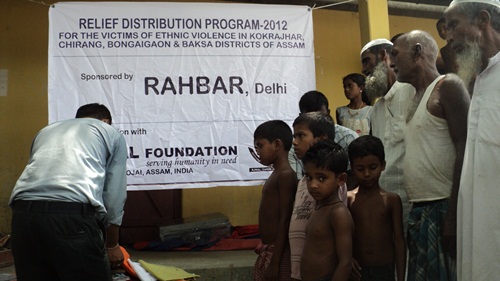
Page-1|Page-2
|
Page-3
|Page-4|Page-5|Page-6
|
Page-7
|
Page-8
|
Page-9
|
BaKhabar  Download pdf Download pdf
|
| Modernization
of madarsa: need for methodology corrective - - By M J
Warsi*
The establishment of the current model of the madarsa can be traced to Nizam ul Mulk (c.1018 92), the Grand Vizier under two Seljuk Sultans. He wrote the influential Siyasat Namah - The Book of Government and founded a series of madarsas all over Iraq and Khurusan (Iran). The biggest of them was the Nazimiya in Baghdad (c.1065). In his book, as in the establishment of these madarsas, Nizam ul Mulk sought to train a cadre of intellectuals and theologians that would guide the Sultans in their governance over the Muslim lands. Nizam ul Mulk's reforms instituted a state-funded (through waqf - land endowment) institute of higher learning that was responsible for creating new elite. The British in India were responsible for both the diminution of the syllabi of madarsas as well as their spread as a counter-British institution. After the 1857 war, the language of the courts was shifted from Persian to English. The Muslim elites who were trained at home and in madrasas in the "classical" subjects were loathe to join the English grammar schools.  While people like Sir Syed Ahmed Khan, argued for a modernization of the Islamic knowledge systems and founded a school which is now known in the World as Aligarh Muslim University. Others like Thanawi, Maududi, Nanotovi etc. opted for enshrining Arabic and the Qur'an at the heart of any system of Muslim knowledge in India. The effect was the growth of two separate strains of Muslim thought in India. In pre-colonial India, the 'alim had to know fiqh, history, sciences, archery etc. to be an effective administrator or jurist, but the colonial counterpart needed only English language and English Law. As a result, the curriculums in the madarsas deteriorated down to just religious law. The service rendered by madarsas to the country and the Muslim community is an established fact. In India these madarsas have played an important role in protecting human, Islamic and social values. These institutes have also played an important role in survival of Islamic practices, dissemination and publication of Islamic literature, protection of Islamic faith and development of Islamic culture and civilization, besides contributing in the development of the country. These invaluable services rendered by Islamic madarsas cannot be forgotten. Kids were sent to madarsas in their earliest age to learn to read the Qur'an and other religious rituals. A minority, only those pursuing a religious living, went on to studying fiqh etc. and the rest went to public or private secular schools. The madarsas existed not in competition with secular Urdu, Hindi or English medium schools but as optional supplements. The main problem in the system is with 'Islamic education' which simply juxtaposes 'religious' subjects with 'secular or modern' subjects.  In 1986, the Indian government initiated a project to modernize madarsa by bringing in subjects like science, math, English, and Hindi. But many madarsas refused to cooperate, wary of the state's interference. Their Hindu equivalent, the Sanskrit schools, has been gradually folded into the state education system. The government has continued its efforts, with limited success, but in 2002 it drew criticism from Muslims when a secret memorandum came to light in which all state education officials were ordered to ensure that madarsas applying for government funding "are not indulging, abetting, or in any other way linked with anti-national activities." The Union government's madarsa modernization scheme has enabled students from various parts of the country to seek jobs of their choice, says Firoz Bakht Ahmed, the grandnephew of Maulana Abul Kalam Azad, better known for his own writings on minority issues and madarsa education. The agenda for reforming the madarsas has, unfortunately, today come to be linked with the question of countering 'terrorism'. Yoginder Sikand in one of his writings focused on efforts being made today by 'ulama and Muslim activists in India to introduce modern subjects in the curriculum, excise subjects and books that are considered irrelevant and introduce reforms in teaching methods. Sikand looked at the ways in which this demand for reform is formulated and legitimated, such as reviving a holistic understanding of knowledge in Islam, doing away with educational dualism, widening employment opportunities for the 'ulama and empowering the Muslim community.  The menace of growing educational backwardness through madarsas that everybody is afraid of can be curbed only by providing a progressive, modern alternative with a promising future for the younger generations, writes Arjumand Ara, a teaching faculty at Delhi University. "We are not going to compromise on the content and structure of Islamic education but certainly welcome any initiative by the government to upgrade the curriculum to have modern education in madarsa system," Maulana Mohammad Wali Rahmani, a well reputed Islamic scholar and the Director of Khanqah Rahmania Munger, Bihar said. It is a well-known fact and one can believe that nothing was ever wrong with the madarsas in India. A well thought statement by Indian Prime Minister Manmohan Singh in Washington DC recently remove all the doubts on the credibility of madarsa when he said, "we have 150 million citizens who practice the faith of Islam. And I say it with some pride about their patriotism that not one of them has joined the ranks of these gangs like the Al Qaeda or other terrorist activities". I visited Khanqah Rahmania Munger, a well-established Islamic seminary in Bihar, I have seen the students besides religious education they were also getting the computer education and comfortably surfing the net. "We have computers, we have books in English, we have students who can converse in English but not militants. The allegation about Madarsa that they produce millitants is completely baseless," said Maulana Rahmani, a supporter of modernization process. "We are more open and have nothing to hide from anyone. If anyone has doubt, is more than welcome to come and have a look", said Maulana Khalid Saifullah, principal of Madarsa Ashrafiya, Saharsa. Demands for the 'modernization' of the madarsa system are today being voiced from many quarters, including from several ulema associated with the madarsa themselves. The voices of ulama advocates of reform are particularly significant, in that they are influential in moulding the opinions and policies of principals of the madarsas, which outside critics are not. It is really time, that when we think of introducing Modern Education into the Madarsas, we should also look at the existing syllabi and incorporate the modern and technical subjects. The madarsa need trained modern teacher, modern subjects (science, computer and humanities) and certainly a modern well structured curriculum along with its own religious contents. -------------------------------- *M J WARSI holds a doctorate in Linguistics and teaches at Washington University in St. Louis, USA. He may be reached at mwarsi@wustl.edu |
Eid
Clothes to Assam Riot Victims, by RAHBAR - NGO of Bihar Anjuman
… A Report by Jawed Ahmed (general secy of RAHBAR, the NGO of Bihar Anjuman), on behalf of his team (Mr. Ishteyaq, Jb. Haseeb sb, father in law of Mr Ishteyaq, and Mr Mumtaz) Objective: Arrangement of new clothes on the eve of Eid, for those Assamese Muslims who were forced to live in camps of Hojaee and Dhubri districts of Asam, after losing their houses and all their possessions due to attack by armed Bodo militants. From 24th Ramzan 2012, I started contacting and talking to the people regarding this issue and kept requesting them to donate only one pair of Kurta-Pajama for adults (or, Rs. 300/=). Everyone was interested in giving money, and this way, I had collected Rs 32,950/=. In the beginning, I had decided to purchase all the items from Old-Delhi so that I could get as many pairs of Kurta-Pajama as possible (within the budget). But one of my students, Mr. Ishtyaq, came forward and suggested me to do all the shopping from a shop named “Fashion Gallery”, located in Zakir Nagar. I was initially hesitant, but finally decided to give it a try. On 28th Ramadan (17th Aug), Juma’atul Vida, we reached the shop after offering Alvida-Namaaz; the lowest price of one pair of Kurta-Pajama was about Rs 500/=, far beyond our expected range (our range was Rs 300/=). Fortunately, Ishteyaq’s father-in-law was very close to the shop-owner; the price of each pair was finally settled at Rs 320/=. So, we ordered for 85 pieces of sizes 38 to 44. Expected weight of all these clothes was around 20 kg., and we were afraid of running short of money required for air-cargo (Rs 180/kg), so, we requested the shopkeeper to take back 10 pieces of size-44. He asked the reason which I explained to him. Then, he returned the money to me, but did not take back those 10 kurta-pajamas. He said that these would be from his side (as his contribution). The shop-owner, then, started giving bunches of kurta-pajamas of different sizes starting from zero size to largest size (for the age group of 5 years to 70 years); I was getting more tense worrying about cargo charges for all these materials to the destination points. Anyhow, we packed all the stuff into two big-sized cartons and took them to courier-wala. It was then 5.30 pm and Iftar time was at 7.15 PM. So, we had shortage of time, plus, huge shortage of money; you can imagine my situation. The total weight of both the cartons was now a whopping 117 kg. (we had hardly purchased 17 kgs.) We realized that the shopkeeper had donated about 100 kg of clothes FREE of cost. Masha-Allah! For distributing the clothes among the affected people, Ajmal Foundation’s manager (Mr Islam) had confirmed they would do it, if we could make the relief-materials reach the affected area anyhow. When I gave the address to the courier-wala, and he quoted the transportation-cost, it left me in an awkward situation, because we did not have that much money. I could not dump those materials anywhere else. It was then that an idea flashed into my mind. I called Mr Islam, manager of Ajmal Foundation, and told him, ”You will have to collect all the stuff from Guwahati airport. If not, then, I am going to the residence of Mr. Badruddin Ajmal sb (President of Ajmal Foundation and Member of Parliament) with all the relief-material”. He replied, “Sir, ho jayega, hum log airport sey hi collect kar leingey, no problem.” The courier charges from Delhi to Guwahati airport came to Rs. 9,360; it was then 6.45pm, already, and we had to literally run back to our homes, for Iftar at 7:15pm. 29th Ramzan (18th Aug) afternoon, Ajmal Foundation had collected the two cartons, the Eid was to be on Monday. On 29th & 30th Ramzan, they distributed all the clothes among our ill-fated brothers. Is kaam mein jitney log ney jis tarah se contribute kiya, Allah unkey gunahoon ko maaf karkey sabhee sey razeee ho jayey. Ameen. Note: The banner bearing the name RAHBAR was made free of cost by brother Hannan. All other banners with the name of RAHBAR and Ajmal Founadation were prepared by Ajmal Foundation.  “Na samjhoge to mit jaoge aey Hindustan walon Tumhari dastan tak na hogi dastanon me…!”   
|
|
Participate
in a good cause;
write to rahbar@rahbar.info
|
|
Home | About Us | Objective | Scholarship | Matrimonial | Video Library | Projects | Quran Resources | Lend a hand |